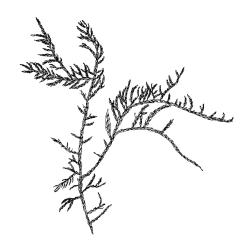- ≡ Acanthocladium Mitt., Trans. & Proc. Roy. Soc. Victoria 19: 85 (1882) nom. illeg., non Acanthocladium F.Muell. 1861, pro parte
The following generic description draws on material in Buck (1986) and Ramsay et al. (2002).
Plants small to medium-sized, dark green or yellow- to brown-green, usually turning golden with age, forming loosely interwoven mats. Stems creeping, irregularly, subpinnately, or bipinnately branched. Branches simple or ± pinnately branched, creeping or ascendant, often with multiple flagelliform and microphyllous branchlets near tips. Stem and branch leaves differentiated. Stem leaves appressed to spreading, broadly ovate to ± oblong, abruptly tapered to a slender, often piliferous and serrulate apex, concave; mid laminal cells (upper third of leaf) linear to linear-rhomboidal or long-hexagonal, firm-walled, seriately papillose abaxially or occasionally smooth, mostly porose; basal cells shorter, strongly porose, and pigmented in N.Z. taxa; alar cells strongly differentiated, those in extreme corners strongly inflated, supra-alar cells irregular, oblong, or ± quadrate; costae short and double or absent. Branch leaves smaller than stem leaves, ovate-lanceolate or lanceolate, the laminal cells finely papillose abaxially or smooth. Specialised asexual reproduction often by flagelliform and deciduous branchlets. Paraphyllia lacking. Pseudoparaphyllia foliose, deltoid (fide Buck 1986).
Dioicous. Perichaetia scattered on stems, conspicuous. Setae elongate, red-brown, smooth, twisted to the left above; capsules ± horizontal, oblong-cylindric, asymmetric, often narrowed below the mouth when dry; exothecial cells isodiametric to oblong, weakly to moderately thickened in corners, often with longitudinal walls thicker than transverse walls; annulus apparently absent; operculum high-conic, lacking a long rostrum. Peristome double, pale; exostome teeth 16, strongly shouldered and bordered, the outer surface cross-striolate below and with a median zig-zag line, the inner surface trabeculate; endostome with a high basal membrane, the segments keeled and perforate and the cilia mostly in pairs or single. Calyptra cucullate, smooth. Spores spherical, papillose.
Wijkia is a predominantly Old World tropical to subtropical genus of approximately 25–30 species, including the four species recognised for the New World by Buck (1986). The generic name was proposed by Crum (1971) to replace the illegitimate homonym Acanthocladium Mitt.; Crum simultaneously selected the Australasian Hypnum extenuatum Brid. as the nomenclatural type of Wijkia. Ramsay et al. (2002) recognised one species in Australia. Only the single species occurs in N.Z.; it is here treated as two varieties, which are distinguished in the key above.
| Category | Number |
|---|---|
| Indigenous (Non-endemic) | 1 |
| Total | 1 |




